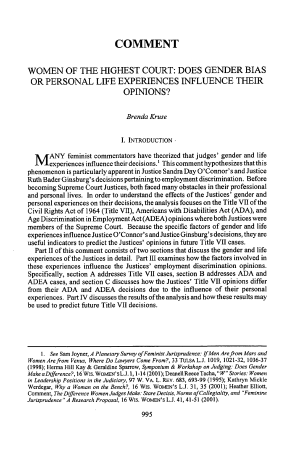Women of the Highest Court: Does Gender Bias or Personal Life Experiences Influence Their Opinions?
January 2005

DISCLAIMER: This text has been transcribed automatically and may contain substantial inaccuracies due to the limitations of automatic transcription technology. This transcript is intended only to make the content of this document more easily discoverable and searchable. If you would like to quote the exact text of this document in any piece of work or research, please view the original using the link above and gather your quote directly from the source. The Sandra Day O'Connor Institute does not warrant, represent, or guarantee in any way that the text below is accurate.
Article Text
(Excerpt, Automatically generated)
COMMENT
WOMEN OF THE HIGHEST COURT: DOES GENDER BIAS OR PERSONAL LIFE EXPERIENCES INFLUENCE THEIR OPINIONS?
Brenda Kruse
I. INTRODUCTION
MANY feminist commentators have theorized that judges' gender and life experiences influence their decisions.1 This comment hypothesizes that this phenomenon is particularly apparent in Justice Sandra Day O'Connor's and Justice Ruth Bader Ginsburg's decisions pertaining to employment discrimination. Before becoming Supreme Court Justices, both faced many obstacles in their professional and personal lives. In order to understand the effects of the Justices' gender and personal experiences on their decisions, the analysis focuses on the Title VII of the Civil Rights Act of 1964 (Title VII), Americans with Disabilities Act (ADA), and Age Discrimination in Employment Act(ADEA) opinions where both Justices were members of the Supreme Court. Because the specific factors of gender and life experiences influence Justice O'Connor's and Justice Ginsburg's decisions, they are useful indicators to predict the Justices' opinions in future Title VII cases.
Part II of this comment consists of two sections that discuss the gender and life experiences of the Justices in detail. Part III examines how the factors involved in these experiences influence the Justices' employment discrimination opinions. Specifically, section A addresses Title VII cases, section B addresses ADA and ADEA cases, and section C discusses how the Justices' Title VII opinions
